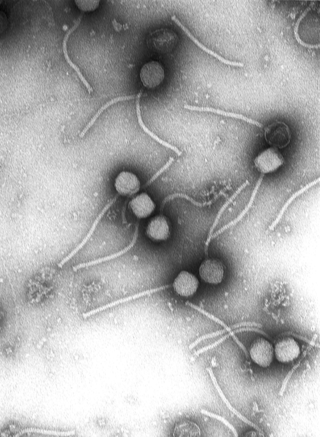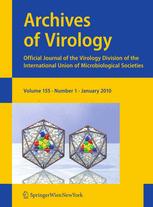
Virology is the scientific study of biological viruses. It is a subfield of microbiology that focuses on their detection, structure, classification and evolution, their methods of infection and exploitation of host cells for reproduction, their interaction with host organism physiology and immunity, the diseases they cause, the techniques to isolate and culture them, and their use in research and therapy.
Circoviridae is a family of DNA viruses. Birds and mammals serve as natural hosts. There are 101 species in this family, assigned to 2 genera. Diseases associated with this family include: PCV-2: postweaning multisystemic wasting syndrome; CAV: chicken infectious anemia.

The Journal of Virology is a biweekly peer-reviewed scientific journal that covers research concerning all aspects of virology. It was established in 1967 and is published by the American Society for Microbiology. Research papers are available free online four months after print publication.

Journal of General Virology is a not-for-profit peer-reviewed scientific journal published by the Microbiology Society. The journal was established in 1967 and covers research into animal, insect and plants viruses, also fungal viruses, prokaryotic viruses, and TSE agents. Antiviral compounds and clinical aspects of virus infection are also covered.

Virology is a peer-reviewed scientific journal in virology. Established in 1955 by George Hirst, Lindsay Black and Salvador Luria, it is the earliest English-only journal to specialize in the field. The journal covers basic research into viruses affecting animals, plants, bacteria and fungi, including their molecular biology, structure, assembly, pathogenesis, immunity, interactions with the host cell, evolution and ecology. Molecular aspects of control and prevention are also covered, as well as viral vectors and gene therapy, but clinical virology is excluded. As of 2013, the journal is published fortnightly by Elsevier.

Lida Holmes Mattman Ph.D. (1912–2008) was an immunologist. She graduated with a M.S. in Virology from the University of Kansas and a Ph.D. in Immunology from Yale University. Mattman taught in the fields of immunology, microbiology, bacteriology, virology and pathology for over 30 years. She worked at various schools and institutions including Harvard University, Howard Hughes Institute, Oakland University and Wayne State University. She was a Professor Emeritus in the Department of Biological Sciences at Wayne State University in Detroit where she was engaged in research and lecturing. She has served as President of the Michigan Branch of the American Society for Microbiology, as Chairman of the Medical Division of the Michigan Academy of Sciences, and held various offices in the local chapter of Sigma Xi.
The Journal of NeuroVirology is a medical journal that publishes review articles on the molecular biology, immunology, genetics, epidemiology, and pathogenesis of CNS disorders with the goal of bridging the gap between basic and clinical studies, and enhancing translational research in neurovirology. It is published by Springer Science+Business Media. The Journal of NeuroVirology is the official journal of the International Society for Neurovirology.
Retrovirology is a peer-reviewed open access scientific journal covering basic research on retroviruses. The journal was established in 2004 and is published by BioMed Central. The editors-in-chief are Johnson Mak and Susan Ross ; earlier, Kuan-Teh Jeang was editor-in-chief.

The Archives of Virology is a peer-reviewed scientific journal covering research in virology. It is published by Springer Science+Business Media and is the official journal of the Virology Division of the International Union of Microbiological Societies. It was established in 1939 as the Archiv für die gesamte Virusforschung and obtained its current title in 1975. According to the Journal Citation Reports, the journal has a 2020 impact factor of 2.574.
Bovine coronavirus is a coronavirus which is a member of the species Betacoronavirus 1. The infecting virus is an enveloped, positive-sense, single-stranded RNA virus which enters its host cell by binding to the N-acetyl-9-O-acetylneuraminic acid recepter. Infection causes calf enteritis and contributes to the enzootic pneumonia complex in calves. It can also cause winter dysentery in adult cattle. It can infect both domestic and wild ruminants and has a worldwide distribution. Transmission is horizontal, via oro-fecal or respiratory routes. Like other coronaviruses from genus Betacoronavirus, subgenus Embecovirus, it has a surface protein called hemagglutinin esterase (HE) in addition to the four structural proteins shared by all coronaviruses.

Marseilleviridae is a family of viruses first named in 2012. The genomes of these viruses are double-stranded DNA. Amoeba are often hosts, but there is evidence that they are found in humans as well. The family contains one genus and four species, two of which are unassigned to a genus. It is a member of the nucleocytoplasmic large DNA viruses clade.

Reverse genetics is a method in molecular genetics that is used to help understand the function(s) of a gene by analysing the phenotypic effects caused by genetically engineering specific nucleic acid sequences within the gene. The process proceeds in the opposite direction to forward genetic screens of classical genetics. While forward genetics seeks to find the genetic basis of a phenotype or trait, reverse genetics seeks to find what phenotypes are controlled by particular genetic sequences.
The Journal of Medical Virology is a monthly peer-reviewed medical journal covering fundamental and applied research concerning viruses which affect humans. It is published by Wiley-Blackwell and was established in 1977. The current editor-in-chief is Shou-Jiang (SJ) Gao.
Future Microbiology is a peer-reviewed medical journal that was established in 2006 and is published by Future Medicine. The editors-in-chief are Richard A. Calderone and B. Brett Finlay. The journal covers all aspects of the microbiological sciences, including virology, bacteriology, parasitology, and mycology.

Intervirology is a bimonthly peer-reviewed medical journal covering all aspects of virology, especially concerning animal viruses. It was established in 1973 and is published by Karger Publishers. The editor-in-chief is Jean-Claude Manuguerra.
Future Virology is a monthly peer-reviewed medical journal published by Future Medicine. The editor-in-chief is Mark Wainberg. The journal covers all types of virus, both from the perspective of human health (vaccines and disease prevention, disease treatment, and drug resistance. The journal was established in 2006 and is published by Future Science Group.
Clinical Microbiology and Infection (CMI) is a monthly peer-reviewed medical journal publishing original research and review articles that assist physicians and microbiologists in their management of patients and the prevention of infectious diseases. CMI publishes manuscripts presenting the results of original research in clinical microbiology, infectious diseases, bacteriology, mycology, virology and parasitology, including immunology and epidemiology as related to these fields. The journal website offers online articles and issues as well as collections according to article type. The journal also publishes editorials, commentaries and reviews, as well as guidelines originating from ESCMID Study Groups. These guidelines and collections make CMI a reference source for infectious disease researchers, for practising clinicians and for informing people of emerging infections and new outbreaks.

Virus Research is a peer-reviewed scientific journal which focuses on fundamental research in all aspects of virology. The journal was established in 1984 by Brian Mahy and Richard Compans.
Journal of Clinical Virology is a scientific journal that covers the aspects of human virology that directly pertains to virus-induced clinical conditions. The journal is published by Elsevier.










